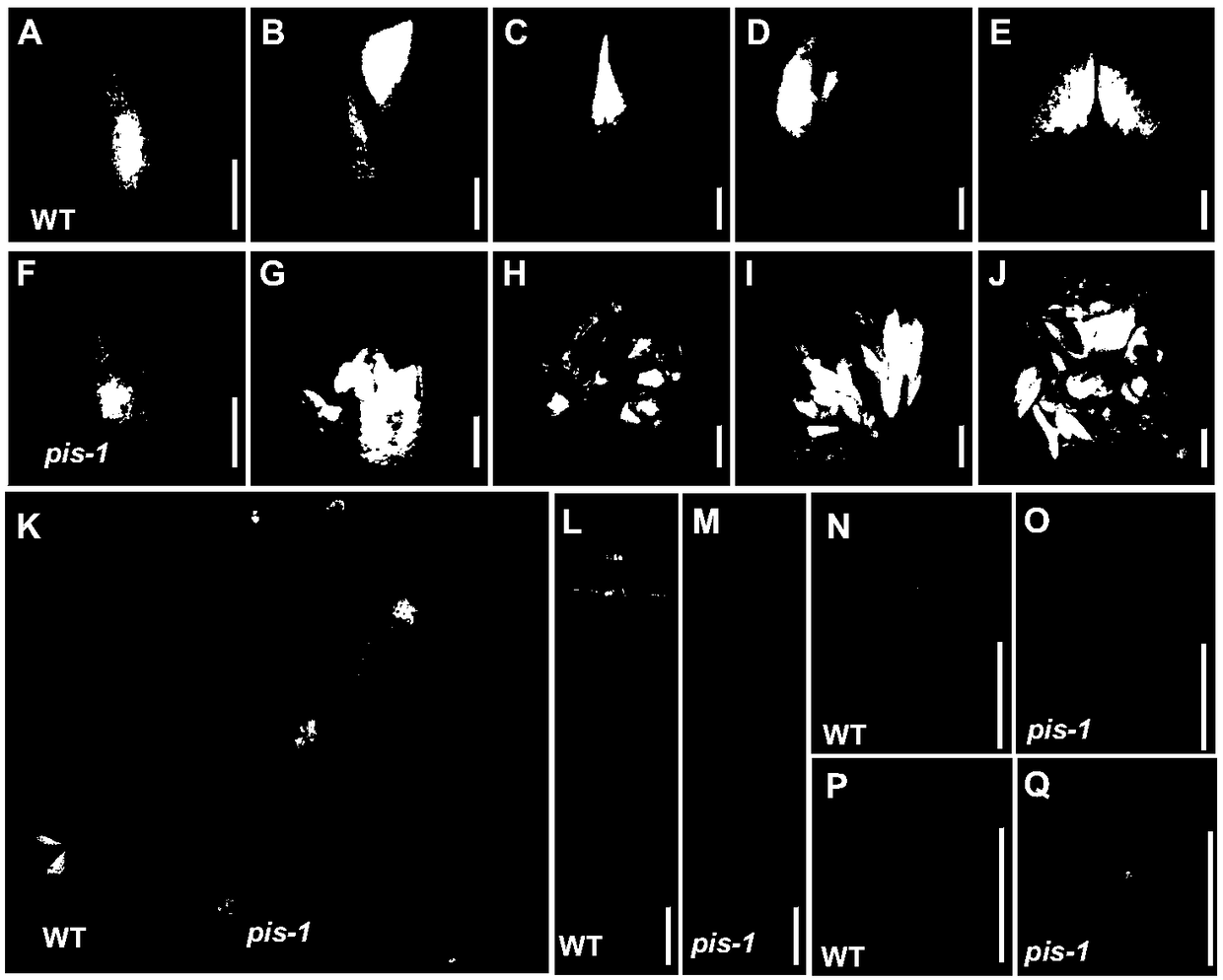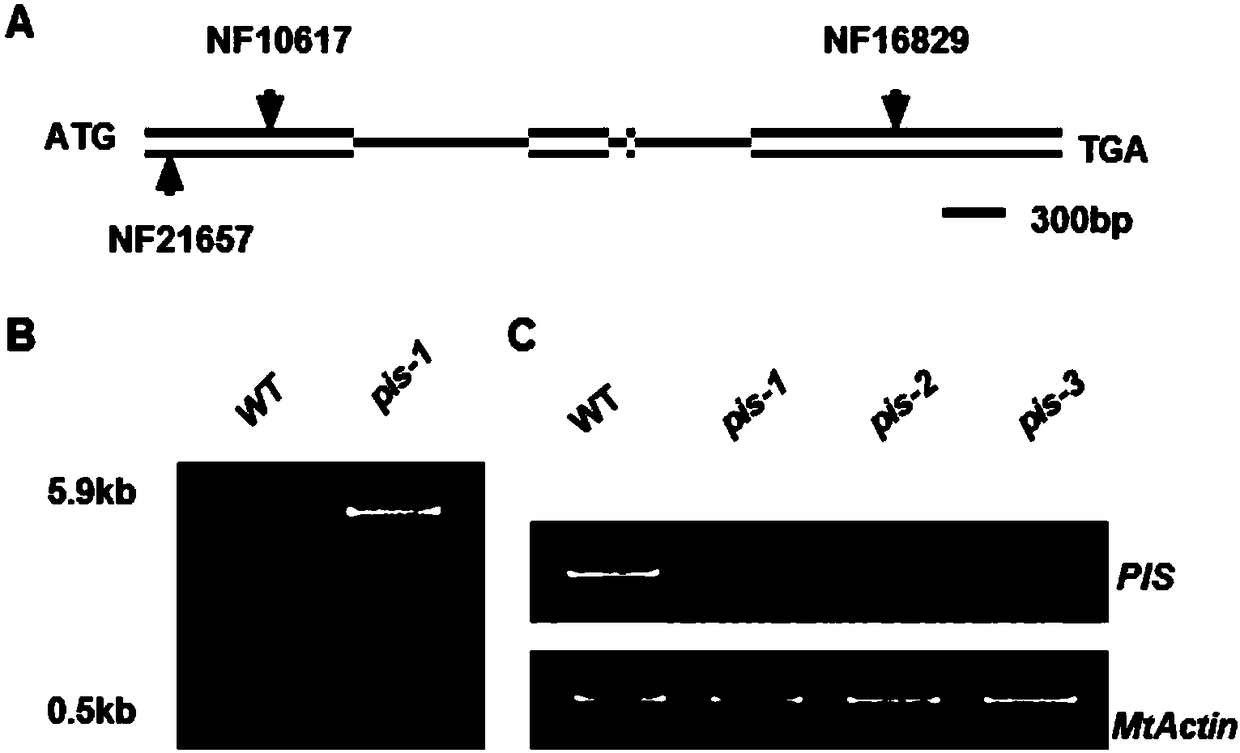Medicago truncatula multi-petal control protein and encoded genes and application thereof
A gene and coding technology, which is applied to the multi-petal control protein of Medicago truncatula and its encoded gene and application field, can solve the problems of protein functional domain deletion, complex regulation of butterfly flower and flower organ development, etc.
- Summary
- Abstract
- Description
- Claims
- Application Information
AI Technical Summary
Problems solved by technology
Method used
Image
Examples
Embodiment 1p
[0034] The acquisition and phenotype analysis of embodiment 1pis mutant
[0035] By screening the Tnt1 insertion mutant library of Medicago truncatula, a mutant NF10617 with increased petals and complete loss of stamens and pistils was obtained, named Petals Increased Severely (pis).
[0036] Detailed phenotypic observations of pis mutants such as figure 1 shown. figure 1 Middle A is the side view of the wild-type flower bud at the floret stage; B and C are the side view and top view of the wild-type young flower, respectively; D and E are the side view and top view of the wild-type mature flower, respectively; F is the pis mutant small Side view of flower bud; G and H are side view and top view of young flower of pis mutant respectively; I and J are side view and top view of mature flower of pis mutant In addition to the increase, there are also calyxes). Compared with the wild type, mutant pis exhibited enlarged buds throughout the flower development period. Figure K sho...
Embodiment 2
[0038] The cloning of embodiment 2PIS gene
[0039] According to the Tnt1 website ( NF10617 published at https: / / medicago-mutant.noble.org / mutant / The flanking sequence, design the corresponding primers,
[0040] NF10617-F:5'-CCTCCTCTAACCTGCTCCA-3';
[0041] NF10617-R:5'-TCACCACCTCTTTCCCATTCA-3';
[0042] Detect linkage of mutants to genes. Finally, we found a gene PIS linked to the mutant, DNA level detection, compared with the wild type, the insertion site of the mutant amplified a band about 5.5K longer than the wild type ( figure 2 B), determined to be Tnt1 sequence by sequencing comparison. In the NF10617 mutant, Tnt1 was inserted in the first exon of the gene. In order to prove that the PIS gene is the control gene of the mutant, we ordered two other mutants of this gene: NF21657 (pis-2 inserted in the first exon), NF16829 (pis-3 inserted in the fourth exon exon) and named the previous NF10617 as pis-1 (see figure 2 A). Observing the phenotypes of the homozygo...
Embodiment 3PI
[0043] The acquisition of embodiment 3PIS gene and its coded protein PIS
[0044] 1. Extract the RNA of the blooming flower of Medicago truncatula R108 (wild type), and reverse transcribe it into cDNA.
[0045] 2. Using the cDNA obtained in step 1 as a template, amplify using a primer pair consisting of primer PIS-F and primer PIS-R to obtain a PCR amplification product.
[0046] PIS-F: 5'-CACCATGGTTGGTGACAAAGGAGA-3';
[0047]PIS-R: 5'-TCACATCAAACCACCACCAC-3'.
[0048] 3. Sequence the PCR amplification product obtained in step 2 to obtain the coding region sequence of the target gene, as shown in sequence 1 in the sequence listing, and encode the protein shown in sequence 2 in the sequence listing. Consists of 1009 amino acid residues. The CDS of the gene was compared on the Medicago website (http: / / blast.jcvi.org / Medicago-Blast / ), and the genome sequence of the PIS gene was obtained, as shown in Sequence 3. The protein shown in Sequence 2 of the Sequence Listing is named ...
PUM
 Login to View More
Login to View More Abstract
Description
Claims
Application Information
 Login to View More
Login to View More - R&D
- Intellectual Property
- Life Sciences
- Materials
- Tech Scout
- Unparalleled Data Quality
- Higher Quality Content
- 60% Fewer Hallucinations
Browse by: Latest US Patents, China's latest patents, Technical Efficacy Thesaurus, Application Domain, Technology Topic, Popular Technical Reports.
© 2025 PatSnap. All rights reserved.Legal|Privacy policy|Modern Slavery Act Transparency Statement|Sitemap|About US| Contact US: help@patsnap.com


